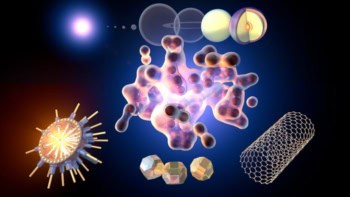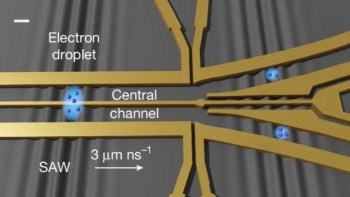
Atomic systems that behave very much like supersolids have been created independently by teams of physicists in Italy, Germany have Austria. The teams have shown that dipolar quantum gases trapped by magnetic fields can spontaneously separate into arrays of coherent droplets, providing a system closer to the original conception of a supersolid.
The supersolid phase is a counterintuitive quantum state of matter that has both crystalline order and frictionless flow at very low temperatures. The phenomenon is related to superfluidity and was predicted 50 years ago by Soviet physicists Alexander Andreev and Ilya Lifschitz. However, supersolidity has proved frustratingly difficult to observe.
In a superfluid, the energy required to create a density modulation generally increases as the modulation’s wavelength gets shorter. At one characteristic wavelength, however, the energy takes a sudden dip – much as waves pass more easily through a crystal when the wavelength equals the separation between the atoms. If the superfluid were cold enough, Andreev and Lifschitz reasoned, the energy required would drop to zero at this wavelength. The superfluid would then spontaneously separate into tiny droplets, effectively forming an ordered crystal.
Difficult to observe
Early attempts at observing a superfluid focused on superfluid helium-4 and in 2004 physicists at Pennsylvania State University in the US reported evidence of helium-4’s supersolidity. Unfortunately, further investigation by the team revealed this to be an experimental error. Despite this setback, efforts to observe supersolidity in helium-4 are ongoing.
In 2017, two research groups – one at ETH Zurich, the other at Massachusetts Institute of Technology – independently observed supersolid phenomena in Bose-Einstein condensates (BECs) of atomic gases. These BECs do not have the natural energy dip at a specific wavelength present in helium-4, but both groups successfully engineered dips by coupling the atoms to a light field. This induced strong electric dipolar interactions between the atoms and consequent attractive interactions. When combined with the repulsive effect of the van der Waals’ interaction, this produced a single, coherent state that could exhibit a marked density modulation and yet still flow without friction. Nevertheless, explains Tobias Donner from the ETH group, “The interaction was imposed from outside – we designed an interaction with the help of light fields, which means the critical distance was given by the light-field wavelength.”
Magnetic interactions
Instead of exploiting electric dipole interactions, which must be imprinted using light, the latest three experiments use magnetic dipole interactions. When the atoms are placed in an external magnetic field, their magnetic dipoles align with it. When the field is low, repulsive van der Waals interactions and zero-point fluctuations dominate, and the system behaves as a standard BEC. However, higher fields can induce the atoms’ magnetic dipoles to align head to tail, causing the atoms to separate into individual droplets, whose distance increases with the field.
If the field is too high, each droplet remains in a separate quantum state and the system is not a supersolid. However, at intermediate fields, the droplets can be brought close enough to allow atoms to tunnel between them, keeping the state coherent. “The regime in which this happens is very narrow,” says Giovanni Modugno of the University of Pisa in Italy, who led the team that first observed the phenomenon.
Modugno’s team and, independently, researchers led by Tilman Pfau of the University of Stuttgart in Germany, used BECs of dysprosium-162. Unfortunately, to create the supersolid phenomena in dysprosium-162 requires tuning the magnetic field to a value that also maximizes the probability of atoms being knocked out of the trap by three-body collisions. The BEC was therefore lost rapidly, and supersolid phenomena could be observed for only a few tens of milliseconds. However, researchers led by Francesca Ferlaino of the University of Innsbruck in Austria used dysprosium-164 instead. This did not suffer from this problem, meaning the researchers could produce BECs lasting up to 150::ms using the same technique.
Longer lifetimes
Moreover, Ferlaino’s team also showed that a supersolid-like state of dysprosium-164 could be produced by cooling alone, producing even longer lifetimes: “After 400::ms the state is still very much alive and robust,” explains Ferlaino. “The properties are preserved for a time long enough to study the spectrum of excitations, the thermodynamic properties, the flow…long enough to really do something with the state.” This will be crucial in subsequent experiments to prove that the state is truly a supersolid.

The return of supersolids
Donner, who was not involved in the latest studies, looks forward to a study of the system’s properties: “What we are all hoping for, of course, is some effect that’s not predicted by theory – some unanticipated new avenue for research.”
Modugno’s team describe their work in Physical Review Letters and Tilman Pfau’s team’s in Physical Review X. Francesca Ferlaino and colleagues’ work is in press in Physical Review X and a preprint is available on arXiv.



